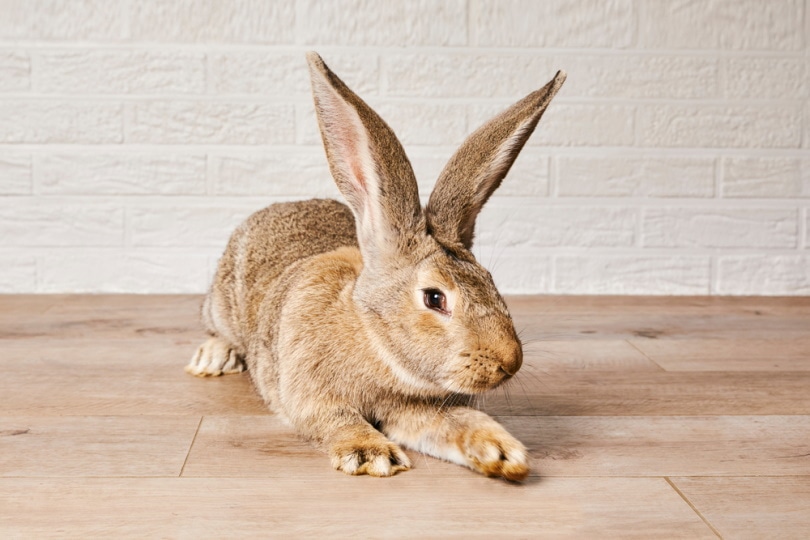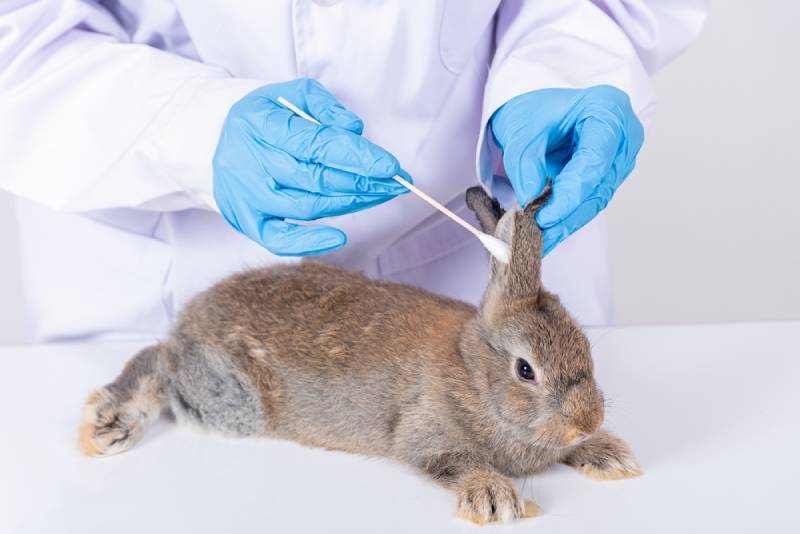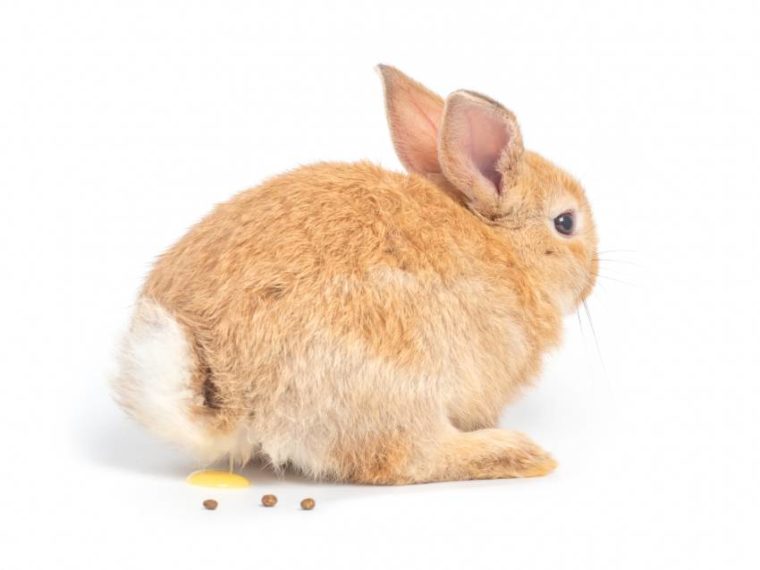
Rabbits are some of the cutest and cuddliest pets to own, and they’re fairly clean as well. They can be litter trained just like cats can, reducing their messes and allowing many rabbit owners to let their pets run freely around the house.
But, even if your rabbit is trained to use the litter box, accidents can happen, many of which you may not find until later. Or maybe you have other pets and can’t give your rabbit a free run of the house. In either case, their urine can leave behind a stain.
Whether you’re cleaning up dried rabbit urine from your home or your bunny’s cage, here are some ideas and tips for how to remove rabbit urine stains and clean up their dried urine.
 Before You Begin
Before You Begin
Before you begin, you should know that rabbit urine can be cleaned up from pretty much any type of surface using white vinegar or a solution of white vinegar and water. To make the solution, combine one cup of water and one cup of white vinegar in a spray bottle. This concentration should be enough to clean up most rabbit urine stains, but you can always add a bit more vinegar if you need the solution to be stronger.
The methods for cleaning rabbit urine from different surfaces vary. So, we’re going to break it down into different surface types so that you can make sure any stain is cleaned effectively. We’ll also explain which materials you might need under each type of surface.

4 Ideas & Tips on How to Clean Up Dried Rabbit Urine
1. Plastic Rabbit Cages/Litter Boxes
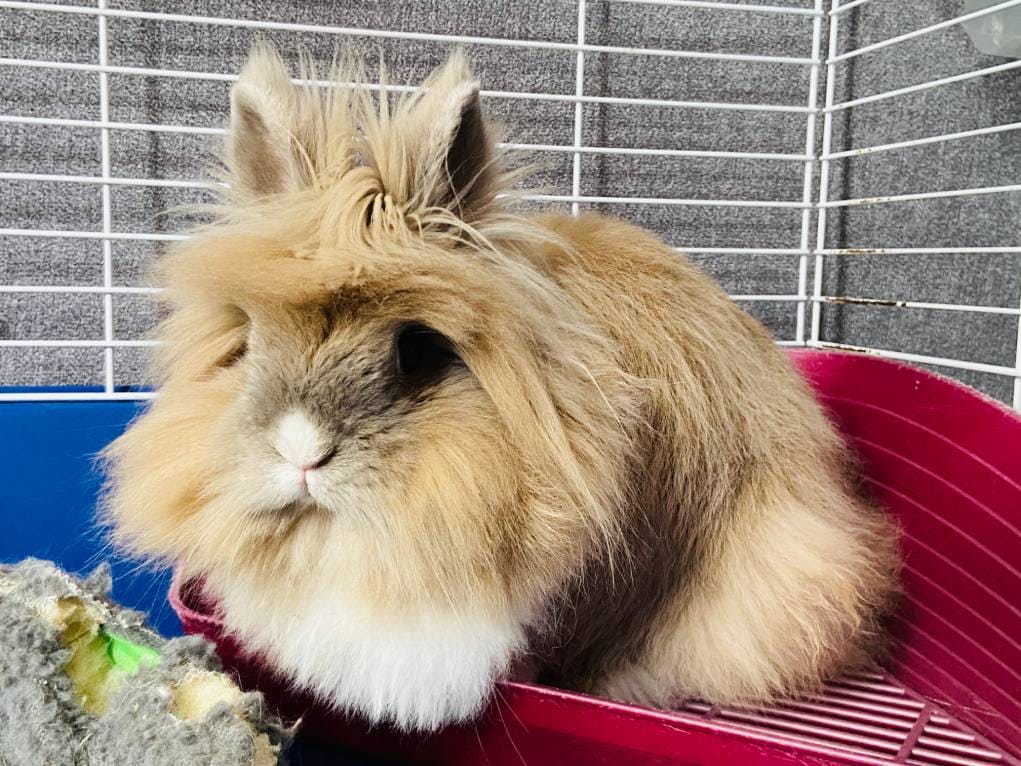
Disclaimer: Before we get into this method, you should know that it works best for rabbit cages made from plastic. If you keep your rabbit in a wooden cage, you will want to use the method recommended for wood below. You will also need to have a temporary place available for your rabbit to stay.
Cleaning rabbit urine on plastic surfaces requires a bit of elbow grease due to the way that the urine builds up on plastic surfaces and leaves behind urine deposits. The good news is that urine is less likely to leave behind a permanent stain on plastic surfaces.
Use Full-Strength Vinegar
The first thing you will want to do is use undiluted white vinegar instead of the vinegar spray you created. Undiluted white vinegar is a more powerful cleaning agent. After cleaning out your rabbit’s cage or litter, pour the white vinegar directly into the bottom until you have a layer that is about one inch thick.
Let the vinegar sit for several hours or even overnight depending on the size of the stain. It must sit for at least two hours to give the vinegar time to break down the urine. After letting the vinegar sit, do not pour it out. Instead, use a scrub brush to scrub the stains. If you’ve scrubbed as much as you can, then you can pour the vinegar out. Repeat the process as necessary until the stains are gone.
2. Wood/Hardwood Floors
Cleaning dried rabbit urine from wood surfaces or hardwood floors may come with special challenges, especially if the stains are large or have been there a while and the wood is varnished, stained, or painted. The reason is that rabbit urine is high in ammonia, which can remove varnishes and paints. Plus, the liquid urine can warp, damage, or rot the wood as well.
With that being said, large urine stains that have caused damage may mean that the wood needs to be replaced or that the floor needs to be refinished. Sometimes, you may not even notice the damage until you’ve cleaned up the urine.
Smaller rabbit urine stains don’t tend to cause as much damage, especially if they haven’t been there that long. But, you’ll still need to clean them to prevent them from causing damage over time. Keep this in mind if you are using a rabbit cage with a wooden floor.
Spray With Vinegar/Water Solution
With further ado, the first thing you’ll need to do to clean rabbit urine from wood is to spray the stained area with vinegar and water solution. Let the vinegar sit on the stain for 5-10 minutes, then wipe it up with a cloth or paper towel. Repeat a few more times if necessary.
Use Hydrogen Peroxide
If the stain is still there, you can try using 3% hydrogen peroxide. But, you’ll want to do a spot test first in a hidden location as hydrogen peroxide can damage hardwood floors. If the spot leaves behind no damage, then you’ll first need to sprinkle baking soda over the stained area.
Then, dip a rag in hydrogen peroxide and place it over the stain. Let it sit for up to 3 hours. Uncover the area and wipe the floor to remove the hydrogen peroxide and baking soda, and hopefully, the stain as well. Repeat a few more times as necessary, but again, large stains that can’t be removed may require refinishing the floor.
3. Fabric/Carpet/Upholstery
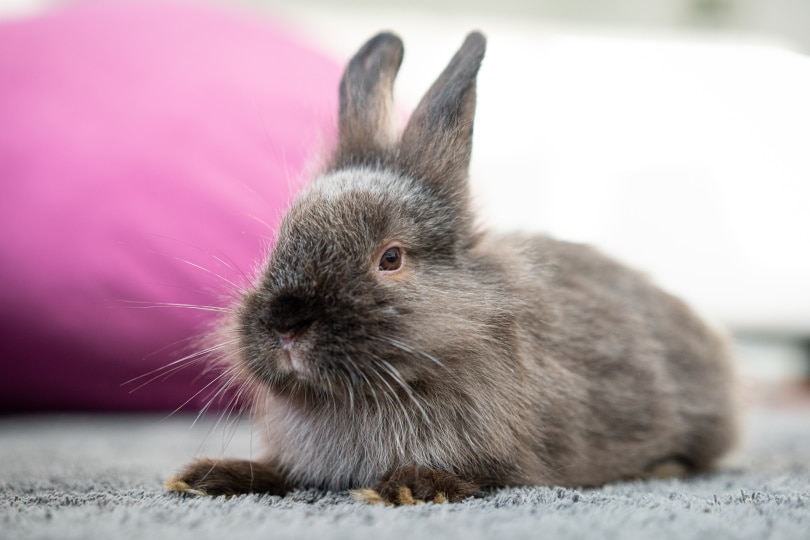
Dried rabbit urine stains are easy to remove from fabrics and upholstery, but the issue here will be getting the odor out. Even if you get the stain out, the odor can remain behind and can even encourage your rabbit to continue peeing in that area.
4. Enzymatic Cleaner
You’ll first need to spray the stained area with an enzymatic cleaner, particularly one that is designed for pet urine. These cleaners contain ingredients that help to break down the stain and odor and even discourage re-marking.
Our Favorite Product
Hepper Advanced Bio-Enzyme Pet Stain & Odor Eliminator Spray is our favorite all-purpose cleaner for pet messes. It permanently lifts the very worst stains and odors, making clean up and accident prevention breeze. Hepper offers a 100% guarantee, which is a great bonus! Learn more about it here.
- ADVANCED ENZYMATIC CLEANER - Penetrates the most stubborn smells and stains at the deepest molecular...
- FOR ANY MESS, ON ANY SURFACE - This pet odor eliminator cleans your carpets, floors, furniture,...
- FRESH, NATURAL ODOR - Our unique formulation doesn't rely on dangerous or unpleasant chemical...
At Pet Keen, we’ve admired Hepper for many years, and decided to take a controlling ownership interest so that we could benefit from the outstanding products of this cool cat company!
Spray With Vinegar Solution
Let the enzymatic cleaner sit for the amount of time suggested on the packaging, which will usually be between 5 and 15 minutes. Then, spray the vinegar spray on the stain to further help break down the stain and odor. Let the vinegar sit on the stain for an additional 5 to 10 minutes.
Sprinkle Baking Soda
Your next step depends on whether the fabric surface is washable or not. For surfaces that can’t be washed, such as carpets and most upholstery, you’ll need to use a cloth to blot up the vinegar. This will help the area dry faster. If the stain and odor persist, sprinkle baking soda on the areas which will help to absorb the odor. Let the baking soda sit for 10 minutes, then repeat the vinegar part of the process.
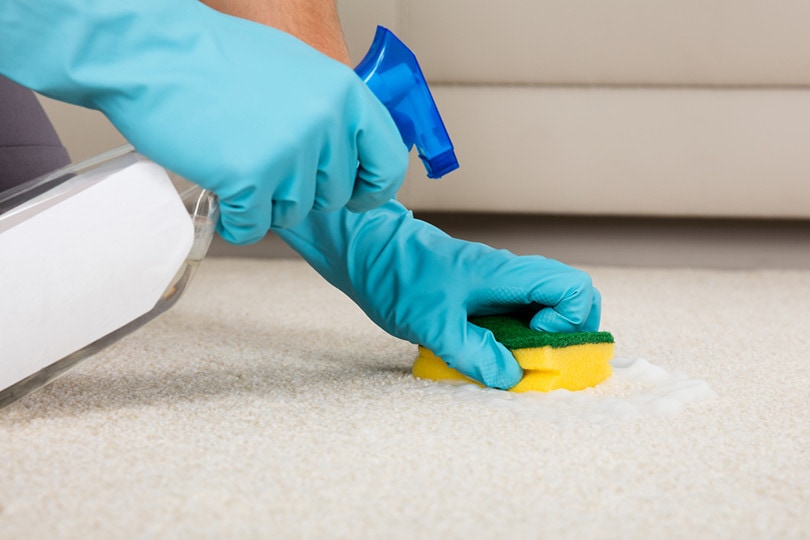
Add Bleach
If the fabric can be washed, such as clothing, bedding, curtains, etc., wash the clothing after letting the vinegar sit for 10 minutes. Don’t blot the vinegar first, as you want it to still be wet when it goes through the washing machine. For white fabrics that are washable, you can add some chlorine bleach to the wash according to the instructions on the packaging. For colored, washable fabrics, you can add oxygen bleach to the wash to boost the stain removal power.
How to Keep Your Rabbit from Peeing on Everything
If you keep your rabbit in a cage, you don’t have to worry about him peeing on everything. But if you let your rabbit roam around the house freely, you’ll want to make sure that he’s not peeing on whatever he can find. There are several ways to do this.
Spraying or Peeing?
Sometimes rabbits are spraying rather than peeing. They usually do this to mark their territory, and it is more common in male and female rabbits that aren’t neutered and spayed. As you can probably guess, the solution to this problem is to spay or neuter your rabbit to cut down on or eliminate the spraying behavior.
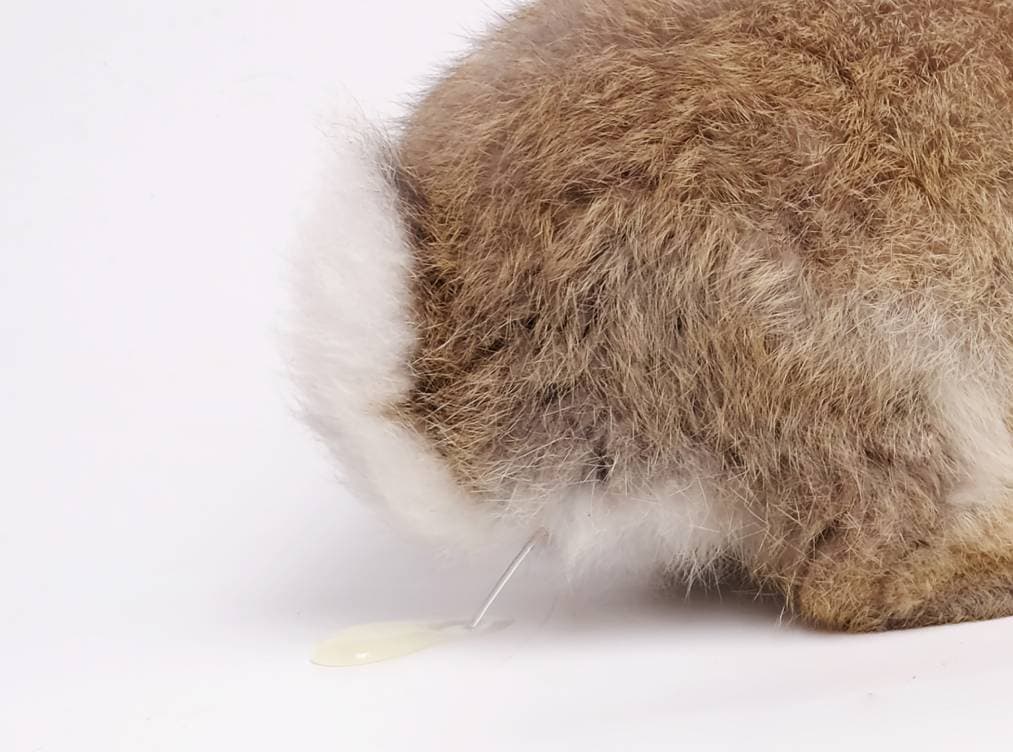
Pee Pads
Another thing you can do is use puppy pee pads, especially if your rabbit is peeing on your hardwood floors. Place them in places where your rabbit has peed before, especially if it’s somewhere that he pees a lot. That way, you only have to change or clean the pee pad instead of the whole floor.
Litter-Train Your Rabbit
Finally, you can litter train your rabbit, even if he lives in a cage instead of inside your home. Again, this is most effective if the rabbit is spayed or neutered. But, you’ll want to start out keeping your rabbit confined to a small space until she learns to use the box. Once the box is being used consistently, confine the rabbit to a larger space, such as one room.
As long as your bunny is using the litter box consistently, you can increase the space. Make sure to clean the box regularly and provide multiple boxes if the rabbit has access to the whole house. This will help to ensure continuous success.
See Also:
- How To Get Rid of Rat Urine Smell (10 Ideas and Tips)
- Why Is My Rabbit’s Pee Red? 7 Possible Reasons (Vet Answer)
 Final Thoughts
Final Thoughts
Unless your rabbit is litter-trained, he’s likely to pee wherever, especially if he’s allowed to roam the house freely. That means you’re likely to find dried urine stains on multiple surfaces. Most of the stains can be cleaned with vinegar, but the exact cleaning methods may differ depending on the type of surface. Once the stains are cleaned, take proactive steps to prevent your rabbit from peeing on everything. That way, you can enjoy his cuteness without having to clean up any unpleasant messes.
Featured Image Credit: Arlee.P, Shutterstock
 Before You Begin
Before You Begin

